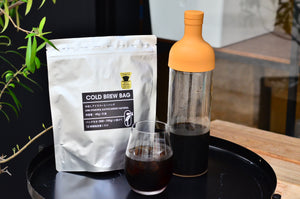It's summer, which means iced coffee, of course! But, what’s the best way to make it, and what kinds of coffee beans should you use?
Keep reading to find out the differences between cold brew and ice brew coffee, the method that 2016 World Brewers Cup champion Tetsu Kasuya personally uses to make the ultimate iced coffee, and which coffee beans you should consider using when making iced coffee at home.
What Is Cold Brew Coffee?

When appropriately prepared, cold brew coffee is smooth, full-bodied, and often has a delicious taste reminiscent of chocolate. Making cold brew coffee is easier than you may think and is ideal for busy people.
4 Reasons You Should Try Making Cold Brew Coffee
- Lower Acidity: Cold brew coffee isn’t as acidic as hot brewed coffee.
- Smoother: Since the coffee grounds aren’t steeped in high temperatures, cold brew coffee has more flavor.
- Less Waste: Cold brew coffee is made from concentrate, which means you can make one cup at a time. The concentrate should keep in the refrigerator for up to two or three days without going stale, unlike hot coffee, which loses its freshness shortly after brewing.
- Versatile: Cold brew coffee can be served in various ways to suit your taste, such as with ice cubes or milk.
How to Make Cold Brew Coffee





What Is Ice Brew Coffee?

While the cold brew method uses room temperature water, the ice brew method uses ice water.
Ice is set on top of coarse coffee grounds, and the coffee is extracted as the water slowly melts and soaks in. Since the ice is allowed to thaw at its natural pace, the extraction process can vary depending on the room temperature. Generally, it takes around 4–8 hours.
You can prepare everything before you go to bed so that you can drink it the following morning. Although it takes time, the appeal is that you can set it and forget it, unlike hot brew coffee, which is best enjoyed with a more practiced method.
Due to the lower temperature, the extraction of bitter components is lower. At the same time, since the contact time with the coffee grounds is longer, the concentration becomes denser. This results in a thicker texture and a taste that is more mellow and pure.
How Tetsu Kasuya Makes Ice Brew Coffee
To make ice brew coffee, use the same process for hot brew drip coffee, but with the following differences.
- Water: Use half water and half ice.
- Ratio: The ratio of (coarsely ground) coffee to ice water should be 1:12 — for example, 50g of coffee, 300g of ice, and 300g of water.
- Steeping: The mixture will take up more space due to the ice, so you’ll need a larger container. We recommend steeping for around 15 hours.
Equipment
The equipment used for iced coffee is the same as that used for drip coffee.
- Dripper: A dripper is an appliance that uses filters and makes it easy to pour water over ground beans to make coffee. One dripper is all you need, preferably a large one to hold both the coffee grounds and ice. See our range of drippers.
- Server: By dripping the brew into a server, it’s easier to transport from point A to point B without spilling. See our range of servers.
- Filter: A filter traps the coffee grounds and allows the liquid to flow through. In Japan, some retro cafe enthusiasts prefer to use a washable fabric filter. However, a paper filter is recommended because it allows the water to drip more slowly. See our range of paper filters.
What Kind of Coffee Beans Should You Use for Cold & Ice Brewing
Hot, cold, and ice brewing extraction methods bring out different textures and flavors from the coffee beans. Thus, many coffee lovers find they prefer different roasts depending on how they prepare the coffee.
Since cold and ice brewing results in lower acidity levels, the brighter notes of light roast coffees tend not to come out as much. Some say this makes the coffee more delicate, while others feel that it results in a muted flavor.
Cold and ice brewing are ideal for emphasizing the strengths of medium and dark roasts while downplaying any bitterness — the result is a satisfyingly full-flavored, smooth cup of coffee.
Specialty Coffee Beans for Cold & Ice Brewing
Since the cold and ice brewing methods bring out such complete and nuanced flavors. They provide an excellent opportunity to explore specialty coffees. Here are a couple of favorites among our collection of sustainably sourced beans.
Philocoffea 014 Rudder Blend—DarkCombining a deep, rich, sweet taste with a crisp and refreshing bitterness, our 014 Rudder Blend—Dark is a well-balanced, deep roast coffee. This blend is composed of beans from Colombia, Brazil, and Guatemala. It aims for a taste that goes beyond the "I'm going to have a good cup of coffee" mood by delivering a satisfying, "Now this is delicious!" moment.
Available all year round, it’s a typical example of the blends Japan’s connoisseurs go-to for cold brew coffee. It’s full-bodied, the bitterness is mellow, and the sweetness of the deep-roasted beans is easily noticed.
098 Ethiopia Kayocamino Natural G1This is the kind of deep-roasted Ethiopian coffee that Philocoffea is known for. The 098 Kayocamino Natural G1 has a deep jammy sweetness like grapes and black currants with a pleasant bitterness. With cold and ice brewing, it’s easy to taste the full fruitiness of this coffee.
Further ExplorationIf you are keen to explore other taste profiles after getting accustomed to the coffees above, we recommend experimenting with light-roasted beans.
It’s Going to Be a Great Summer!

We hope you found this introductory guide helpful in learning how to make cold brew and ice brew coffee at home. Coffee purists will love both the process of experimenting with different specialty coffees, steeping durations, and proportions until they find their dream brew.
Whether you go with a regular cold brew or Tetsu Kasuya’s ice brew technique, with some planning, you’ll be able to make rich and subtly complex ice cold coffee that is ready in your refrigerator whenever you want a refreshing drink this summer.

